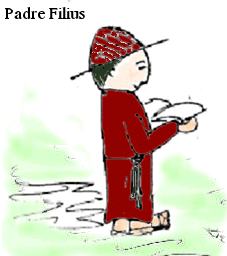
And for my Good Readers, here’s the new reviews and articles for this month. The ARJ2 ones are new additions to the top of A Reader’s Journal, Volume 2, Chronological List, and the ART ones to A Reader’s Treasury.
1.) ARJ2:
Life of Pi --- A Novel by Yann Martel
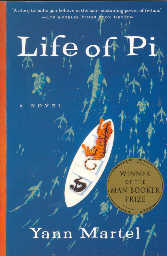
The essence of the story that Pi tells the author is presented on the cover of the book: a 450 lb. Bengal tiger and a 16-year-old Indian boy are adrift in a lifeboat in the middle of the Pacific Ocean for almost nine months and survived to tell the story. Well, the tiger ran off into the jungle, and the boy grew into a man who told the story. And what a story it is — one to shock, astonish, amaze, and stretch one's credulity to the limit.
What kinds of shocks are to be found in this novel? Here’s a few:
One day Pi and his brother received an important lesson about the animals in their father’s zoo. “A lesson that might save your lives,” he told them seriously, while his wife tried to talk him out of giving their sons the lesson. The lesson was a live goat thrown into a cage with a starved tiger. They watched as the tiger streaked across the cage and devoured the goat. Their teary-eyed mother was furious at the father for what he’d done, scaring their sons like that. His reply was telling.
[page 36] “Gita, my bird, it’s for their sake. What if Piscine had stuck his hand through the bars of the cage one day to touch the pretty orange fur? Better a goat than him, no?”
 After the tiger demonstration, Pi’s father took him to each of the animal cages, and explained the dangers that each of the animals posed to human beings, the lions, the bears, the hippos, the hyenas, the antelopes, the ostriches, the orangutans, etc. Pi had no way of knowing just how valuable this lesson was going to be when later he found himself stranded on a lifeboat with a 450-lb Bengal tiger, a spotted hyena, an orangutan and a zebra.
After the tiger demonstration, Pi’s father took him to each of the animal cages, and explained the dangers that each of the animals posed to human beings, the lions, the bears, the hippos, the hyenas, the antelopes, the ostriches, the orangutans, etc. Pi had no way of knowing just how valuable this lesson was going to be when later he found himself stranded on a lifeboat with a 450-lb Bengal tiger, a spotted hyena, an orangutan and a zebra.
Pi was a Hindu, a Christian, and a Muslim. His parents couldn’t understand how Pi could belong to all three religions, but it made no difference to Pi. He saw all three ways as leading him to God. After he became a Christian he gave thanks to Krishna for having made it possible.
[page 58] I entered the church, without fear this time, for it was now my house too. I offered prayers to Christ, who is alive. Then I raced down the hill on the left and raced up the hill on the right — to offer thanks to Lord Krishna for having put Jesus of Nazareth, whose humanity I found so compelling, in my way.
Then he met a Sufi, a Muslim mystic, who had the exact same name as his biology teacher, Satish Kumar, a common name in the region, and who taught him about being a Muslim.
He called them Mr. and Mr. Kumar.
[page 61] Mr. and Mr. Kumar taught me biology and Islam. Mr. and Mr. Kumar led me to study zoology and religious studies at the University of Toronto. Mr. and Mr. Kumar were the prophets of my Indian youth. 
When pleaded with by his parents to choose just one religion, his answer was that Bapu Ghandi said, “All religions are true.” Pi said that he just wanted to love God. Each of the religions had individuals that shooed away or otherwise encouraged him to leave the mosque, the church, or the darshan. Pi simply found a way to avoid such people and continue to go to all three. He seemed able always to take life as he found it and make the best of it. Like when it came time for him and his family to leave India for Canada on a ship with many of the animals from the zoo that his father sold to zoos in North America.
When the ship sank quickly in the middle of the Pacific Ocean, he was thrown overboard into a dangling lifeboat and bounced on the tarp covering it. Then a full-size zebra fell onto the tarp, breaking the middle seat of the lifeboat and the ropes from which it dangled in the air, and Pi hit the water with the detached lifeboat, which saved him from being dragged down with the ship. He saw a beloved tiger called Richard Parker from the zoo struggling to stay afloat nearby, and he blew his whistle to coax the 450 pound tiger to come aboard. At the last moment he realizes the folly of his automatic life-saving instinct — he remembered his father’s lesson at the zoo and realized that, if Richard Parker got into the lifeboat, Pi would become “the next goat” as his older brother often threatened him with. But it was too late to stop it, and the tiger reached the boat and climbed under the tarp in the far end. Luckily Pi was there first and he had established his territory. He was going need every bit of animal training lore and knowledge of animals to survive the next day.
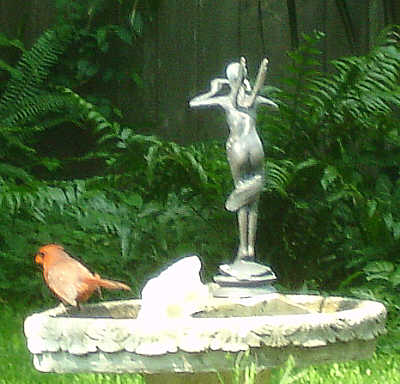
He was in a 27-foot long zoo containing a mother orangutan, a spotted hyena, a zebra with a compound fracture in one leg, and healthy, hungry Bengal tiger.
Imagine Pi in the boat with his life-preserver’s whistle taming the tiger. Marking off his half of the lifeboat with his urine and blowing the whistle to put the tiger off balance. He needed the tiger to attempt to attack him so he could apply the most effective intimidation. He scraped a turtle shell and used it for a shield. When the tiger raked at him, his paws only clawed the shell, and Pi responded with a shrill blow of the whistle and the tiger shrank back. Soon Pi was off the makeshift raft and sleeping soundly in the lifeboat.
But his problems had only begun. He had barely enough food and water for himself, and, unless he fed the tiger, he would become food for the tiger, and he knew it. The stores also contained fishing gear and Pi became a fisherman. For the first time in his life, he had to kill a living animal, a fish, to survive. He tossed the first large fish he caught to Richard Parker who summarily gulped it down. Occasionally a flock of flying fish would pass over the boat and provide a quick afternoon
snack of those he and the Richard Parker could knock down into the boat.
Pi’s voyage was interrupted by an inhospitable island, but it took him some time to discover the life-threatening nature of the island. The island seemed to be made completely of plant life. Some advanced kind of algae that formed into concentric tubes so that seawater went through the tubes’s walls but the salt was filtered out and concentrated in one of the tube’s walls while only freshwater was in the other tube.

Pi quickly discovered that he had stumbled unto an endless supply of fresh water in ponds throughout the island. In addition, saltwater fish which swam into these ponds, or were chased by sharks, quickly died and floated to the surface of the ponds, providing freshly killed fish for his larder. There were no bugs, insects, or wildlife of any kind on the island, except for the docile meerkats, a kind of prairie dog animal which had never developed a fear of other animals because they lacked any predator on the island. Richard Parker soon regained all the weight he had lost on the long journey, and the shine was back on his furry coat. His diet of fish was quickly replaced by an endless supply of meaty meerkats. The tiger stayed on the island during the day, ate till he was full, and then returned to sleep in the lifeboat.
Every biologist, even a beginning one like Pi, knew that a tree must reproduce, so he began looking for signs of fruit. Finally he found some black fruit in one tree.
[page 278] It wasn’t the largest in the forest, or in its dead centre, or remarkable in any other way. It had good level branches, that’s all. It would have made an excellent spot from which to see the sky or take in the meerkats’ nightlife.
I can tell you exactly the day I came up on the tree: it was the day before I left the island.
What made Pi leave this apparently hospitable island so quickly? What was the mysterious black fruit? Why were there no bugs, birds, or life of any kind except the meerkats on the living island? Why did the meerkats scamper into the trees to spend the night? The answer to these puzzles are at the heart of a mystery which Pi encountered in the Pacific — a mystery about the island that only a man in a lifeboat with a mature Bengal tiger could have lived to report.
You have to read it to believe it. And even then you might not.
Read the Review at:
http://www.doyletics.com/arj/lifeofpi.htm
2.) ARJ2:
Theosophy, GA# 9, Supersensible Knowledge and Destination of Humankind by Rudolf Steiner
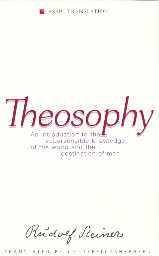
In this book Steiner gives us detailed descriptions of the spiritual world which are invaluable to
understanding the remainder of his many works. At one point he mentions that this book could be
considered as an introduction to his magnum opus, "An Outline of Occult Science". I first read this book
in 1996 and wrote a short review of it here. Then I read Occult Science and did a short review of it here.
Now, after reading over 150 other Steiner books, I am re-reading Theosophy. I have felt at times that I had
missed something along the way. Now I know what I had missed: this book — a deeper reading of it.
Reading it again has filled out many gaps in my own understanding of Steiner's works, and I encourage all
newcomers to Steiner to read it early and late in your studies as it will provide a solid basis for
understanding the rest of his writings.
A high school pal of mine visited me about thirty years ago and asked me an interesting question,
"Why aren't you doing physics?" I don't recall how I answered him, but this question has stayed with me.
It was only recently that I came to understand that physics has always been the foundation of all the work I
have done, from my work on stable isotopes at Oak Ridge, Tenn., to my research at Tulane Biomedical
Computing System, to offshore well-logging, to computer programming, to real-time programming, to
compiler design, to software research, to neuro-linguistic programming, to nuclear plant maintenance and
scheduling, to the founding of the science of doyletics, to studying of Rudolf Steiner's works, and to my
writing. Each of these work experiences has built upon the solid foundation I laid for myself in my choice
to acquire a degree in physics as a young man.

As I progressed, I became interested in the study of the human brain, the study of psychology, and
finally the study of the really big questions which physics and the other sciences left untouched: Where do
we come from? Where do we go from here? This led me on a quest to study the fringes of science called
metaphysics and led me to discover Rudolf Steiner who stood out saliently as someone who brought the
study of occult or hidden knowledge under the aegis of a science, his spiritual science or anthroposophy.
In his works, I found the answers I had been longing to find for so long. And, once more, I found that his
work built solidly upon my foundation in physics — work which in no way contradicted my physics, but
rather supplanted it with knowledge of the aspects of the real world which are not susceptible to our
normal sensory perception.
When one studies Rudolf Steiner, one must leave behind forever the insidious notion that the real
world consists only of those things we perceive with our sensory organs of perception. Imagine if a blind
person claimed that light didn't exist because she had never seen it. There are fish in underwater lakes in
Kentucky whose eyes have disappeared because no light reaches them. There is an organic give and take
between our perception and the world around us. Our eyes came to be because of the irritation of light on
our heads led to their formation in order to perceive the source of the irritation. Likewise our ears came
into being because there was noise. But the spiritual world impinges not upon our human physical bodies
and thus produces no stimulus for us to form perceptual organs to perceive the spiritual world. The
stimulus for such organs must come from within the human being by a voluntary act. As blind people
might be encouraged by reports of those who see to undergo a procedure to allow them to see the physical
world, so might we be encouraged by Rudolf Steiner to undergo an procedure to perceive the spiritual
world.

[page 8, April, 1922] It is by inner exertion of soul that man must reach the
supersensible world. That world would indeed have no value if it lay spread out
complete before his consciousness. It would then be in no way different from the sense
world. Before it can be known, there must be the longing to find what lies more deeply
hidden in existence than do the forces of the world perceived by the sense. This
longing is one of the inner experiences that prepare the way for a knowledge of the
supersensible world. Even as there can be no blossom without first the root, so
supersensible knowledge has no true life without this longing.
The soul, being built for the supersensible world, can not have evolved by the processes described
by Darwinians in their evolutionary scheme which has humans evolving from the animal kingdom. Try to
imagine a scenario in which the human soul could have evolved from a fish, or a platypus, or a brachiating
monkey. The human lungs could have, but not the human soul. It is for this reason that one must in all
honesty make a sharp distinction between the animal kingdom and the human kingdom. No one argues
that plants vary sharply from minerals, that plants vary from animals, but because the distinction requires
an organ of perception which most humans do not have, there is much argument about the distinction
between animals, especially higher primates, and human beings.

In Chapter I of his book, Steiner paints for us a picture of the human being as a combination of
body, soul, and spirit in, and later in Chapter III, he paints a picture of the Soul World, Spirit Land, and
their connection with the Physical World. This is the preparation he gives us for our entry upon The Path
of Knowledge of the supersensible world in Chapter IV.
I was puzzled at first by many things Steiner said and was skeptical. But I always maintained a
healthy skepticism that my scientific training might be wrong when applied outside of the scope of its
jurisdiction, the physical world. I found myself naturally asking a version of the question Steiner proposes,
"If the things asserted here are true, do they afford a satisfying explanation of life?" Time and again, I
would answer the question with a resounding, "Yes!" Steiner offered me explanations that were complete
and robust for questions for which my scientific training had offered me incomplete or weak answers, or in
many cases, no answers whatsoever. And I found confirmation as he predicted in my own life and the lives
of others that I studied.
For a long time as I was studying Rudolf Steiner's works, my wife and copy-editor kept asking me,
"What exactly does he mean by 'soul'?" and I was at a loss to explain the term "soul" simply and
succinctly to her, up until now. The soul is the part of us that comprises the impressions which our sensory
apparatus in its operations leaves upon us. Note that sensory data is necessarily transient — it exists only
in the moment and then disappears. But sensory data leaves traces inside of us which we cannot share with
another human being. We cannot tell them such a simple thing as what the color red looks like to us, for
example. All we can do is point to an object we see as red and say "I see that as red."  We can agree with
others that the object is what we call red, but we can never unfold for them the color that we see inside of
us. Always our agreement on a color must revert to the external sensory fields. Our individual reaction
therefore to the color red is something that is accumulative over the course of our lifetime in a human body
and everyone has a different life history and therefore a different reaction to the color red.
We can agree with
others that the object is what we call red, but we can never unfold for them the color that we see inside of
us. Always our agreement on a color must revert to the external sensory fields. Our individual reaction
therefore to the color red is something that is accumulative over the course of our lifetime in a human body
and everyone has a different life history and therefore a different reaction to the color red.
Steiner makes a case for a human being consisting of body, soul, and spirit. He derives the
existence of the body, soul, and spirit directly from everyday observable facts which do not require some
ancient text or dogma for one to accept as being true. One can grasp their significance from one's
circadian experience. One cannot proceed further in the study of spiritual science if one does not
understand how every human being consists of body, soul, and spirit.
Perhaps some of you know people who object to Steiner's writings. Likely the source of their
objections stemmed in whole or in part from their preconceived notions of body, soul, and spirit acquired
through other texts, dogmas, or beliefs. It is hard to explain to objectors how simple it is to study Steiner's
work compared to studies which they cite as disagreeing with Steiner. Yet it merely requires them to read
the above paragraph to clarify in their own minds what comprises body, soul, and spirit. This is basic
foundation of Steiner's spiritual science, the sturdy rock which holds up the rest of the structure.
The human kingdom is related to the lower three kingdoms because each of the operations of the
three kingdoms appear in the human being.

[page 20, 21] As we observe minerals, plants, animals, so can we observe man also. He
is related to these three forms of existence. Like the minerals he builds his body out of
the materials of Nature; like the plants he grows and propagates his species; like the
animals, he perceives the objects around him and builds up his inner experiences on
the basis of the impressions they make on him. We may therefore ascribe to man a
mineral, a plant, and an animal existence.
When talking in detail about our soul-nature, Steiner discusses how we cannot perceive how
another perceives — any perception is a private affair that we cannot share directly with someone else, but
only indirectly by external comparisons, by talking, by analogies, etc. All three aspects of experiencing —
sensation from without, feelings from within, and will through which we act on the outside world — all
three aspects comprise the human soul in its operation.
The world impinges upon us, but each of us creates within us, with our soul a world which is
completely individual and personal, which we cannot share with others any more than we explain to them
the color red that we experience when we see a rose or a red wagon. And yet it is not only the events
which impinge upon our body which affect our soul-being, our thoughts also have an effect on our soul.
Can anyone deny that as a reality? What is not commonly understood, but Steiner makes clear, is that our
thoughts derive from a spiritual origin.

Steiner gives us a view of the soul as being intermediary to the body and the spirit. This concept
may be difficult for those who have been indoctrinated by a religious dogma which dropped the concept of
"man as body, soul, and spirit" around the ninth century.
Some readers may be wondering if they are expected to take all of what Steiner is writing about on
faith, and, if not, how they could experience these realities for themselves. The good news is that by
reading they are already taking the first step. When one wants to learn a complicated task, like riding a
bicycle for the first time or doing a gymnastic feat, does it not help to watch others do the task first — to
listen to them describe how to do it?
[page 130, 131] To one who asks, 'How can I gain personal knowledge of the higher
truths of spiritual science?' the answer must be given, 'Begin by making yourself
acquainted with what is communicated by others concerning such knowledge'. And
should he reply I want to see for myself; I do not want to know anything about what
others have seen', the answer must be: 'It is in the very assimilating of the
communications of others that the first step towards personal knowledge consists.'
And if he should retort: 'Then I am compelled first of all to have blind faith', one can
only reply that in regard to some communications it is not a case of belief or disbelief,
but merely of unprejudiced assimilation. The genuine spiritual investigator never
speaks with the expectation of being met with blind credulity. He merely says, 'I have
experienced this in the spiritual regions of existence and I am narrating these
experiences of mine'. But he knows, too, that the assimilation of these experiences by
another and the fact that the thoughts of that other person are permeated by the
account are living forces making for spiritual development.
Then he summarizes how the learning process works in those who are unbiased about obtaining
spiritual insight. Obviously, the skeptical should not apply until they have cleared themselves of their
"you-have-to-prove-it-to-me" attitude. Spiritual science is a "prove-it-to-yourself" proposition.
[page 131] The unconscious knowledge rises to meet the spiritual facts discovered by
another. This is not blind credulity but the right working of healthy human reason.

In this next passage, Steiner uses an interesting phrase, "favorite thought." If you are familiar with
the work of Thomas Kuhn, it may occur to you that scientists have "favorite thoughts" about their
particular field at a given time in history, such as Newton's laws, and then at a later time, they replace or
supplement those favorite thoughts with new favorite thoughts, such as from Einstein's theory of
relativity. Kuhn used a then-obscure word, paradigm, to talk about Steiner's concept of favorite thoughts
some fifty years later.
[page 139] Should a favorite thought present itself to him, he must put it aside if the
right sequence will be disturbed by it. If a personal feeling tries to force upon his
thoughts a direction not proper to them, he must suppress it.
What Steiner recommends for spiritual seekers meshes with what Kuhn recommends for scientists.
One should always be aware of one's paradigm and be ready to set it aside when new information presents
itself which may be outside the paradigm.
But how can we know if there is some truth outside of any paradigm or set of favorite thoughts?
Steiner relates a question asked out of someone's favorite thought and answers the above question for us.
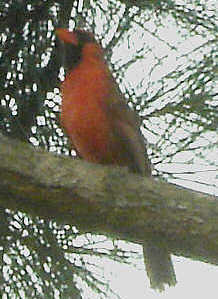
[page 141] One cannot say, 'Of what use to me are the precepts to follow purely the
laws of the True when I am perhaps mistaken as to what is the True?' What matters
is the striving and the attitude to it. Even a man who is mistaken has in his very
striving after the True a force which diverts him from the wrong path. If he is
mistaken, this force guides him to the right paths. Even the objection, 'But I may be
mistaken', is harmful misgiving. It shows that the man has no confidence in the power
of the True. For the important point is that he should not presume to decide on his
aims and objects in life in accordance with his own egotistical views, but that he
should selflessly yield himself up to the guidance of the spirit itself. It is not the self-seeking human will that can prescribe for the True; on the contrary, the True itself
must become lord in the man, must penetrate his whole being, make him a mirror-image of the eternal laws of the Spiritland. He must fill himself with these eternal laws
in order to let them stream out into life.
This review constitutes my short summary of Steiner's Theosophy. I don't know exactly where I
am on that path to knowledge, but I find bread crumbs left behind for me to follow by Rudolf Steiner who
definitely was on that path. Each book of his I read drops several more bread crumbs on my path to follow.
I found it necessary to re-read more deeply this introductory book of his because it contained some key
bread crumbs I needed to progress on my own path that I had overlooked in my first reading attempt. My
hope is that you, dear Reader, will follow the crumbs which I have dropped in this review and wish to
learn more for yourself.
Read the Review at:
http://www.doyletics.com/arj/theosop1.htm
3.) ARJ2:
"I Won't Learn From You" -- and other Thoughts on Creative Maladjustment by Herbert Kohl
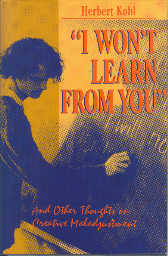
The author starts off with what could be considered a Primer for Not-Learning. Because his
mother didn't speak Yiddish, he decided not to learn Yiddish so that he wouldn't be party to
conversations which involved his father and his grandparents who spoke it a lot. Here's how he went
about making sure he didn't learn to speak Yiddish:
[page 3] There was Yiddish to be heard everywhere in my environment, except
at public school: on the streets, at home, in every store. Learning to not-learn
Yiddish meant that I had to forget Yiddish words as soon as I heard them.
When words stuck in my head, I had to refuse to associate the sounds with any
meaning. If someone told a story in Yiddish, I had to talk to myself quietly in
English or hum to myself. If a relative greeted me in Yiddish, I responded with
the uncomprehending look I had rehearsed for those occasions. I also remember
learning to concentrate on the component sounds of words and thus shut out the
speaker's meaning or intent. In doing so I allowed myself to be satisfied with
understanding the emotional flow of a conversation without knowing what
people were saying. I was doing just the reverse of what beginning readers are
expected to do -- read words and understand meanings instead of getting stuck
on particular letters and the sounds they make. In effect, I used phonics to
obliterate meaning.

Seems an unlikely personal history of someone who became a well-known educator and
author on the subject of education, doesn't it? But we find well-known doctors who do research on
the mal-functions of the human brain, for example, in order to figure out how a normal brain
functions. There's a lot to be seen if you observe, as Yogi Berra liked to say.
Kohl makes the very important point that as a free individual, a student in school may choose
to adopt a not-learning strategy, and instead of dealing directly with the not-learning strategy, they
treat it as a major threat to the entire system of education. Given that parents and school authorities
are more interested at times in discipline instead of drawing out the best from children (the essence
of what education means), this is not surprising. So how do these disciplinarians respond to a single
student's not-learning strategy? Not as simply as Herbert's rabbi did to his not-learning Hebrew
strategy. They respond by over-kill -- when you can't shoot one evasive duck, you call in your
buddies with machine guns and kill all the ducks that fly just to get that one tricky duck.
[page 11] Experts are consulted, complex personal or family causes are
fabricated, special programs are invented, all to protect the system from
changing itself and accommodating difference. People then get channeled into
marginal school experiences and, too often, marginalized lives.
To quote Kohl's own words, "A decent world can only be made by people whose growth has
not been stunted by the imperatives of others." (Page 88)

Kohl's book is a testament to the creative maladjustment that Carl Gustav Jung called
individuation. Sigmund Freud took his patients who were maladjusted because of their neuroses and
removed the neuroses or ameliorated them so his patients became normal well-adjusted human
beings again. On the other hand, Carl Jung took his patients who were well-adjusted people who
were living normal, but empty lives and helped them to individuate or become creatively maladjusted
so that they might live unusual but fulfilling lives.
Recent movies have portrayed examples of creative maladjustment in which teachers have
taught their students to become productive members of society through poetry (Dead Poets Society,
1989), rock and roll (School of Rock, 2003), ballroom dancing (Take the Lead, 2006), and writing
in journals (Freedom Writers, 2007). In every case we find the school administrators fighting
aggressively against change at every step of the way, often striving to oust the teacher. Only after the
results have been proven, will they finally relent, if ever. And some may even come to agree that,
well, maybe, this is a good way to teach our students.
One of my favorite comic strips growing up was Lil Abner, drawn by Al Capp. He was a
celebrity in the mid-twentieth century when his mythical Dogpatch creations turned into a musical
and then a movie. He gave us such memorable creations as Sadie Hawkins Day, the Triple-Whammy, the Schmoos, Daisy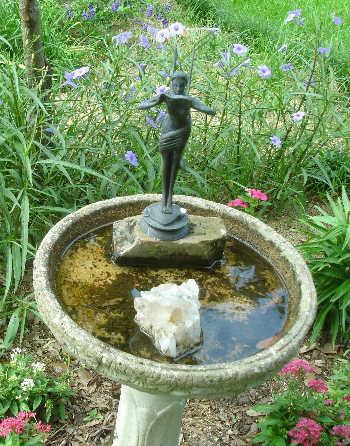 Mae, Moonbeam McSwine, and many others. One of the things little
known about Al Capp was that he walked on a prosthetic leg from an early teenager. In fact after he
was run over by a trolley and lost a leg, he was deemed to be retarded and sent to a school for
retarded children! Imagine the state of an educational system back then which could have thought
that losing a leg causes one to become stupid! His autobiography, My Well-Balanced Life on a
Wooden Leg is an eye-opener for school systems yet today. Our school systems have recovered from
this one version of stupidity, but have created multiple versions of modern stupidity to replace it, to
which they are as blind now as the system which condemned Al Capp to the retarded school.
Mae, Moonbeam McSwine, and many others. One of the things little
known about Al Capp was that he walked on a prosthetic leg from an early teenager. In fact after he
was run over by a trolley and lost a leg, he was deemed to be retarded and sent to a school for
retarded children! Imagine the state of an educational system back then which could have thought
that losing a leg causes one to become stupid! His autobiography, My Well-Balanced Life on a
Wooden Leg is an eye-opener for school systems yet today. Our school systems have recovered from
this one version of stupidity, but have created multiple versions of modern stupidity to replace it, to
which they are as blind now as the system which condemned Al Capp to the retarded school.
Teachers today are like Al Capp who have lost a leg to the relentless and unstoppable trolley
of the administrators who want them to fill all of their time with curriculum plans and pre-canned
texts that they are expected to read to their students. The very agent of crippling the teachers then
defines them as retarded so that the teachers themselves must have their lesson plans prepared for
them to fit some national grading system. The successful teacher has the challenge before them as
Al Capp did: "How to become a Well-Balanced Teacher on a Wooden Leg." Only by creative
maladjustment can these teachers succeed and ensure that our children will survive a public school
system which seems to be designed mostly to ensure that the administrators survive the system, up
until now.


